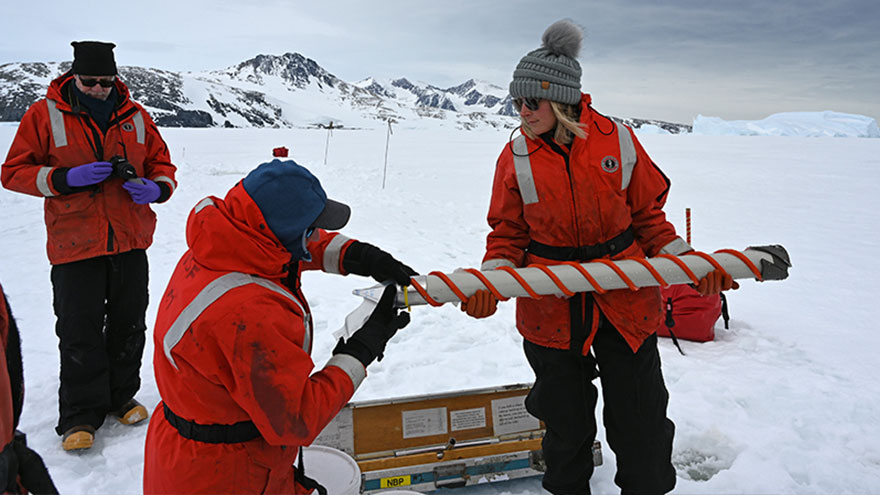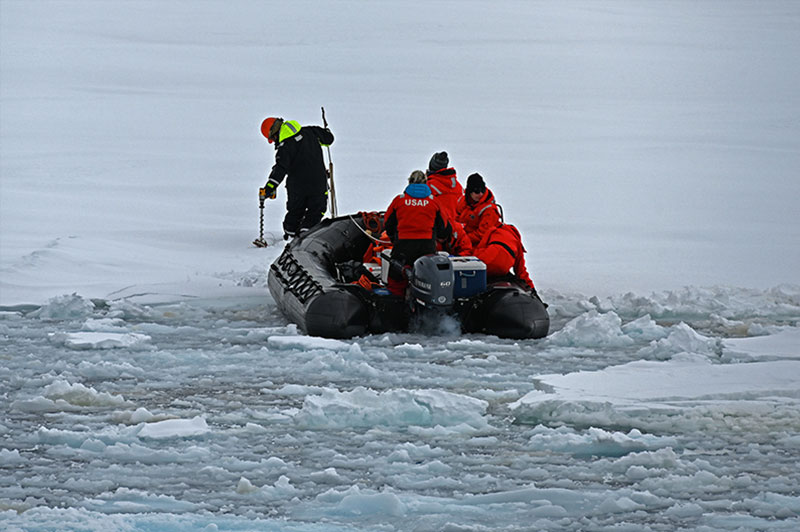Ice Sampling
December 1, 2019 | Dr. Wade Jeffrey, Director of CEDB | wjeffrey@uwf.edu

One of the projects on board is interested in looking at the development of the ice algae community as the spring season progresses and in the ice of different ages. Our project is also interested in the microbial communities that you find in ice samples. In a nutshell, if you look on the underside of sea ice it often appears to be brown. We see this as the ship breaks through the ice and the ice is turned over (see photo). This is an annual process that jump starts the food web, provides a critical food source for krill (who are, in turn, a critical food source for penguins and whales). It’s a process that progresses as the season does, but may vary depending on where you are (farther south, less light, colder than more northern areas of the southern ocean) or the age and type of ice (fast ice attached to the shore, first-year ice, multi-year ice, pancake ice formed offshore, etc). Of course, it also varies by how much ice cover there is. Ice varies greatly from year to year. This year it seems to be pretty heavy (we’ve had some slow going breaking through ice in some places).
From a research ship, there are basically three ways to get off the ship to sample ice. We have used all three. Perhaps the simplest, which works for hard fast ice, is to drive the ship into the ice until its stable, then simply lower the gangway and walk onto the ice. While it sounds simple, it’s a very careful process to make sure the ship is stable and then the ice is checked to make sure it’s OK to walk on. Before we go out, the ice is checked for thickness and hardness using steel poles and drilling. An area is marked off and then we can descend the gangway. Sampling is done by Kovacs Agar. While you can spin these by hand, here we attached them to a power drill and drill down. Here is a photo of my grad student, Leila Harris, drilling a core for her thesis work. Once the core is up, we remove the end and collect the ice in sections into long sterile plastic bags. In Leila’s case, we are interested in looking for bacteria that have specific abilities to capture light energy. Here is also a close up of the very bottom of the core where you can see the young ice algae community growing.
The second way to get to the ice is from a small boat, like a zodiac. In this case, you deploy the zodiac and run over to the ice piece you want. Again, if the ice is thick and stable enough, you can get off the boat and take your cores. If it’s not, you can always try to collect by leaning out over the edge of the boat.
The third way is to sample via the “man basket.” We have used this in the past to sample large ice flows out in open water. It’s also the best way to sample ice if the ice is not firm and secure enough to actually walk on. In this, you load into the man basket and are hoisted out off the ship using one of the cranes. If the ice is secure, you can get off the basket and sample (here is a photo from a previous trip). However, on this trip, the man basket has been used when the ice is not secure and sampling is done simply by hanging off the basket to collect “chunks” (that might be the scientific term) of brown ice.
The ice is brought back on board and melted so that it can be processed – this includes measures of growth rates, biomass, microscopy, and filtration for various parameters. It takes up to three days to fully process a set of ice samples from one location so it’s not something we do very often.
Side note: Back to Palmer Station. We had to make a quick trip back to Palmer Station and the conditions were remarkably different than when we were there just a few weeks ago. If you’ve been reading along, there was too much ice in Arthur Harbor to use the zodiacs. In contrast, this week the harbor was ice-free and easy to navigate.








